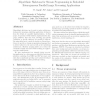PPL
2008
14 years 3 months ago
2008
Algorithmic skeletons intend to simplify parallel programming by providing a higher abstraction compared to the usual message passing. Task and data parallel skeletons can be dist...
FMOODS
2007
14 years 4 months ago
2007
Abstract. Algorithmic skeletons are a well-known approach for implementing parallel and distributed applications. Declarative versions typically use higher-order functions in funct...
ICCS
2004
Springer
14 years 8 months ago
2004
Springer
We show in this paper how to evaluate the performance of skeleton-based high level parallel programs. Since many applications follow some commonly used algorithmic skeletons, we id...
IPPS
2006
IEEE
14 years 9 months ago
2006
IEEE
Algorithmic skeletons can be used to write architecture independent programs, shielding application developers from the details of a parallel implementation. In this paper, we pre...
IAT
2006
IEEE
14 years 9 months ago
2006
IEEE
To manage load on large and dynamic networks we have developed Autonomous Mobile Programs (AMPs) that periodically use a cost model to decide where to execute. A disadvantage of d...
EUROPAR
2007
Springer
14 years 9 months ago
2007
Springer
Abstract. Algorithmic skeletons correspond to a high-level programming model that takes advantage of nestable programming patterns to hide the complexity of parallel/distributed ap...
IPPS
2008
IEEE
14 years 9 months ago
2008
IEEE
A file data model for algorithmic skeletons is proposed, focusing on transparency and efficiency. Algorithmic skeletons correspond to a high-level programming model that takes a...
PDP
2010
IEEE
14 years 10 months ago
2010
IEEE
—This paper argues that algorithmic skeletons are a suitable programming model for multi-core architectures. -level abstractions offered by algorithmic skeletons provide a simple...







